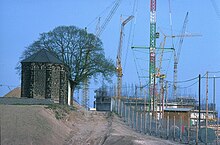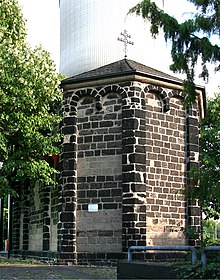Chapel on the good man
The Am Guten Mann chapel stands on a small hill on the Rhine at river kilometer 605.5 in the immediate vicinity of the Mülheim-Kärlich nuclear power plant in Rhineland-Palatinate . It was built in 1838 based on a design by Johann Claudius von Lassaulx ; It has always been the property of the parish of Kärlich.
History from the 12th to the 19th century
Chapel and infirmary
In 1162 there is evidence of an infirmary at this point, to which a chapel may already have belonged, but which is only documented in 1389. At that time Carthusian monks from Koblenz looked after the sick (mainly lepers ) who were housed at the "Guten Mann" and held services in the chapel.
On March 25, 1499, the auxiliary bishop of Trier, Johann von Eindhoven, consecrated a new building. This was unusual because consecration is an act of consecration that is generally reserved for parish churches . From that time on, the number of sick people housed in several infirmaries continued to grow, but decreased at the end of the 17th century, so that the buildings fell into disrepair as a result of the reduced use.
From 1746 to 1747 a new chapel was built, which was destroyed in 1795 during the French Revolution in 1795 when Neuwied was bombarded. However, the citizens managed to get the inventory (especially pictures and statues) to a safe place. In 1838 today's chapel was built with the typical stylistic features of the Koblenz master builder Lassaulx: color change in the stone material, arches below the roof and pilaster strips .
Origin of the name "good man"
The name of the chapel comes from the sick who were allowed to walk from the infirmary within a certain area to the local border, where the residents made gifts for them. They had to make themselves felt with a rattle. As they did so, they shouted, "Good man!" To say that they came with peaceful intent. The limit up to which the sick were allowed to approach the place was marked by the wayside shrine Job (dialect abbreviation for Job ) in Rheinstrasse.
Hermits on the Good Man
Around 1700, hermits came to the Good Man, who initially looked after the sick and, after the infirmary was closed, accommodated people passing through. According to tradition, it was also their job to warn skippers and raftsmen with a lamp in the dark . The last hermit of the Good Man died on September 1, 1765.
The chapel from 1838
The masonry of the chapel - a small, single-nave sacred building with an altar apse facing west (three - eighth closure) - consists of basalt lava and tuff . The roof is covered with slate . The building is 8 m long on the outside and 5 m wide on the east side. In front of the chapel there is an approximately 5.50 × 5.00 m covered free space, which, like the interior, is covered with basalt slabs.
inner space
A three-part baroque altar dates from around 1700. It was only later that an oil painting was added to the middle field of the altar, which shows St. Bernard of Clairvaux embracing the crucified Christ. The painting is dated to the late 18th century. Since the renovation in 1980/81 there has been a Pietà at the place of this picture, as it probably had its place there earlier. Additional furnishings included a Madonna on the crescent moon (around 1750), statues of the Evangelist John and St. John of Nepomuk as well as four small wooden sculptures, a crucifix and a painting depicting the fourteen Holy Helpers .
The Pietà of the Good Man
The patrons of the chapel are St. Nicholas and the Sorrowful Mother of God , who was represented in a wooden statue from around 1630. In 1951 efforts were made to assign this Pietà with a finely crafted head of Christ to the era of Tilman Riemenschneider (1460–1531), whereupon the paint, consisting of several layers, was removed and the wood exposed. Since 1990 the figure has been painted again (which corresponds to the original condition) and is in the parish church of St. Mauritius .
The Pietà, which has formed the center of the chapel since 1981, was created by the Offenbach sculptor Irma Rückert (1923–2006). The wood of this statue is natural, according to the historical model, as it was shown in the period from 1951 to the end of the 1970s.
Statues of patron saints
After all the other statues and paintings, like the old Pietà, were brought to the Kärlich parish church in the early 1970s for security reasons, Irma Rückert created four small figures in 1982, which are patron saints of the history of the chapel and the Kärlich parish. On the left of the altar are St. Mauritius and St. Maria Magdalena , the patrons of the Kärlich church. On the consoles at the transition from the nave to the apse, Johannes Nepomuk is depicted on the left and Nikolaus von Myra , the patron saint of boatmen, on the right. The veneration of St. John Nepomuk on the good man began in 1762 with a donation from Baron Ignatius Franz von Ehrenfels, a chamberlain and guard of the three last Electors of Trier, for an annual "Hohes Am (b) t" in honor of the saint "for living and dead doer ”.
window
Scenes from the daily work of the hermit of the good man are shown in two opposite round windows. The 1981/82 pictures by the Trier painter and graphic artist Werner Persy show the hermits caring for a leper and using a lantern to warn the boatmen on the Rhine of the dangers of the river. In the background of the window on the south side of the chapel you can see the old Kärlich church, on the north side facing the Rhine the White Tower, a former customs tower, after which the town of Weißenthurm , located near the Good Man, is named.
See also
literature
- Kubach / Michel / Schnitzler: The art monuments of the Koblenz district. Verlag von L. Schwann, Düsseldorf 1944
(reprint 1981, ISBN 3-590-32142-3 ). - Josef Schmitt: Mülheim-Kärlich. Published by the Mülheim-Kärlich community in 1981.
- Josef Schmitt: The Chapel of the "Good Man" on the Rhine. Brochure for the reopening and dedication of the chapel on May 24, 1981.
Web links
Individual evidence
- ^ Winfried Henrichs: City Chronicle Mülheim-Kärlich. Ed. City of Mülheim-Kärlich, 2009, p. 246.
- ^ Udo Liessem: Studies on the work of Johann Claudius von Lassaulx…. Görres-Verlag, Koblenz 1989, ISBN 3-920388-03-8 , p. 156.
- ^ Winfried Henrichs: City Chronicle Mülheim-Kärlich. Ed. City of Mülheim-Kärlich, 2009, p. 249.
- ^ Josef Schmitt in Mülheim-Kärlich. Edited by Winfried Henrichs on behalf of the municipality of Mülheim-Kärlich, 1981, p. 244.
- ↑ a b Risse / Spurzem: Parish and Parish Church of St. Mauritius Kärlich. Ed. Kath. Kirchengemeinde St. Mauritius Kärlich, Mülheim-Kärlich 1991, pp. 31–37.
- ^ Rhein-Zeitung Koblenz, Issue B, No. 206 of September 4, 1951.
- ^ Rhein-Zeitung No. 220 of September 23, 1982.
- ↑ Josef Schmitt: The chapel of the "Good Man" on the Rhine. P. 16 and p. 19.
- ↑ Bernhild Peschka: Chapel at the cooling tower shows an old face. In Rhein-Zeitung No. 98 of April 28, 1981.
Coordinates: 50 ° 24 ′ 35 ″ N , 7 ° 28 ′ 52 ″ E





